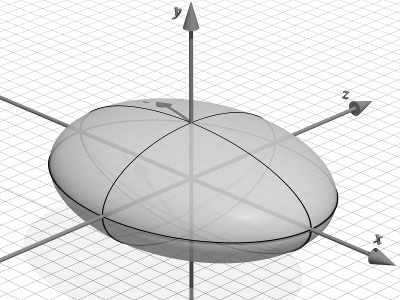Difference between revisions of "Ellipsoid"
m (Expanded image caption) |
Ulf Rehmann (talk | contribs) m (mr,zbl,msc) |
||
| Line 1: | Line 1: | ||
| + | |||
''(real)'' | ''(real)'' | ||
| + | {{MSC|51}} | ||
{{TEX|done}} | {{TEX|done}} | ||
| Line 7: | Line 9: | ||
</span> | </span> | ||
| − | + | An ellipsoid is | |
| + | a closed central [[Surface of the second order|surface of the second order]] (see [[#Fig1|Figure 1]]). | ||
The canonical equation of an ellipsoid has the form | The canonical equation of an ellipsoid has the form | ||
| Line 34: | Line 37: | ||
{| | {| | ||
|- | |- | ||
| − | |valign="top"|{{Ref|Be}}||valign="top"| M. Berger, "Geometry", '''II''', Springer (1987) | + | |valign="top"|{{Ref|Be}}||valign="top"| M. Berger, "Geometry", '''II''', Springer (1987) {{MR|0882916}} {{ZBL|0606.51001}} |
|- | |- | ||
| − | |valign="top"|{{Ref|Co}}||valign="top"| J. Coolidge, "A history of the conic sections and quadric surfaces", Dover, reprint (1968) | + | |valign="top"|{{Ref|Co}}||valign="top"| J. Coolidge, "A history of the conic sections and quadric surfaces", Dover, reprint (1968) {{MR|0245397}} {{ZBL|0060.01006}} |
|- | |- | ||
| − | |valign="top"|{{Ref|Pe}}||valign="top"| C.M. Petty, "Ellipsoids" P.M. Gruber (ed.) J.M. Wills (ed.), ''Convexity and its applications'', Birkhäuser (1983) pp. 264–276 | + | |valign="top"|{{Ref|Pe}}||valign="top"| C.M. Petty, "Ellipsoids" P.M. Gruber (ed.) J.M. Wills (ed.), ''Convexity and its applications'', Birkhäuser (1983) pp. 264–276 {{M|R0731103}} {{ZBL|0512.00020}} |
|- | |- | ||
|} | |} | ||
Revision as of 21:32, 24 April 2012
(real)
2020 Mathematics Subject Classification: Primary: 51-XX [MSN][ZBL]

An ellipsoid is a closed central surface of the second order (see Figure 1).
The canonical equation of an ellipsoid has the form $$ \frac{x^2}{a^2} + \frac{y^2}{b^2} + \frac{z^2}{c^2} = 1 $$ The positive numbers $a$, $b$ and $c$ and the segments of corresponding lengths are called the semi-axes of the ellipsoid. The section of an ellipsoid by any plane is an ellipse.
If two semi-axes of an ellipsoid are equal, the ellipsoid is called an ellipsoid of revolution, and the sections of an ellipsoid of revolution by planes parallel to the plane of the equal semi-axes are circles. When $a=b=c$, the ellipsoid is a sphere. The centre of symmetry of an ellipsoid is called the centre of the ellipsoid.
A second-order surface with canonical equation $$ \frac{x^2}{a^2} + \frac{y^2}{b^2} + \frac{z^2}{c^2} = 1 $$ is called an imaginary ellipsoid.
Comments
As the name suggests, an imaginary ellipsoid does not have real points.
Other characterizations of an ellipsoid are as follows: An ellipsoid is the affine image of a sphere; an ellipsoid is a non-degenerate quadric without real points at infinity.
A systematic treatment of ellipsoids is given in [Be], Chapt. 15 and [Co]. A more advanced survey is contained in [Pe].
References
| [Be] | M. Berger, "Geometry", II, Springer (1987) MR0882916 Zbl 0606.51001 |
| [Co] | J. Coolidge, "A history of the conic sections and quadric surfaces", Dover, reprint (1968) MR0245397 Zbl 0060.01006 |
| [Pe] | C.M. Petty, "Ellipsoids" P.M. Gruber (ed.) J.M. Wills (ed.), Convexity and its applications, Birkhäuser (1983) pp. 264–276 Template:M Zbl 0512.00020 |
Ellipsoid. Encyclopedia of Mathematics. URL: http://encyclopediaofmath.org/index.php?title=Ellipsoid&oldid=25304